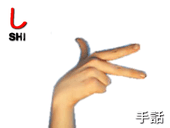Shi (kana)
し, in hiragana, or シ in katakana, is one of the Japanese kana, which each represent one mora. Both represent the phonemes /si/ although for phonological reasons, the actual pronunciation is [ɕi] (![]()
| shi | ||||
|---|---|---|---|---|
| ||||
| transliteration | shi, si | |||
| translit. with dakuten | ji, zi | |||
| hiragana origin | 之 | |||
| katakana origin | 之 | |||
| spelling kana | 新聞のシ (Shinbun no "shi") | |||
| kana gojūon | ||||||||||||||||||||||||||||||||||||||||||||||||||
|---|---|---|---|---|---|---|---|---|---|---|---|---|---|---|---|---|---|---|---|---|---|---|---|---|---|---|---|---|---|---|---|---|---|---|---|---|---|---|---|---|---|---|---|---|---|---|---|---|---|---|
|
||||||||||||||||||||||||||||||||||||||||||||||||||
This character may be combined with a dakuten, forming じ in hiragana, ジ in katakana, and ji in Hepburn romanization; the pronunciation becomes /zi/ (phonetically [d͡ʑi] or [ʑi] in the middle of words).
The dakuten form of this character is used when transliterating "di" occasionally, as opposed to チ's dakuten form, or a de assigned to a small i; for example, Aladdin is written as アラジン Arajin, and radio is written as ラジオ.
In the Ainu language, シ is used to represent the ʃi sound. It can also be written as a small ㇱ to represent a final s sound, pronounced ɕ.
| Form | Rōmaji | Hiragana | Katakana | |
|---|---|---|---|---|
| normal | sh/s- alone (さ行 sa-gyō) |
final sh (s) shi (si) shii (sii) shī (sī), shih (sih) |
し しい, しぃ しー |
ㇱ シ シイ, シィ シー |
| sh/sy- and yōon (しゃ行 sha-gyō) |
sha (sya) shaa (syaa) shah (syah) shā (syā) |
しゃ しゃあ しゃー |
シャ シャア シャㇵ シャー | |
| shu (syu) shuu (syuu) shū (syū), shuh (syuh) |
しゅ しゅう しゅー |
シュ シュウ シュー | ||
| sho (syo) shou (syou) shoo (syoo) shō (syō), shoh (syoh) |
しょ しょう しょお しょー |
ショ ショウ ショオ ショー | ||
| with dakuten | j/z- alone (ザ行 za-gyō) |
final -j (-z) ji (zi) jii (zii) jī (zī), jih (zih) |
じ じい, じぃ じー |
ジ ジイ, ジィ ジー |
| j/zy- and yōon (じゃ行 ja-gyō) |
ja (zya) jaa (zyaa) jā (zyā), jah (zyah) |
じゃ じゃあ じゃー |
ジャ ジャア ジャー | |
| ju (zyu) juu (zyuu) jū (zyū), juh (zyuh) |
じゅ じゅう じゅー |
ジュ ジュウ ジュー | ||
| jo (zyo) jou (zyou) joo (zyoo) jō (zyō), joh (zyoh) |
じょ じょう じょお じょー |
ジョ ジョウ ジョオ ジョー | ||
| Other additional forms | |||||||||||||||||||
|---|---|---|---|---|---|---|---|---|---|---|---|---|---|---|---|---|---|---|---|
|
| ||||||||||||||||||
Stroke order
 Stroke order in writing し |
 Stroke order in writing シ |


Other communicative representations
| Japanese radiotelephony alphabet | Wabun Code |
| 新聞のシ Shinbun no "Shi" |
|
|
 |
 | |
| Japanese Navy Signal Flag | Japanese semaphore | Japanese manual syllabary (fingerspelling) | Braille dots-1256 Japanese Braille |
- Full Braille representation
| し / シ in Japanese Braille | Sh/J + Yōon braille | ||||||
|---|---|---|---|---|---|---|---|
| し / シ shi | じ / ジ ji | しい / シー shī | じい / ジー jī | しゃ / シャ sha | じゃ / ジャ ja | しゃあ / シャー shā | じゃあ / ジャー jā |
| Sh/J + Yōon braille | |||||||
| しゅ / シュ shu | じゅ / ジュ ju | しゅう / シュー shū | じゅう / ジュー jū | しょ / ショ sho | じょ / ジョ jo | しょう / ショー shō | じょう / ジョー jō |
| Character | し | シ | シ | ㇱ | じ | ジ | ||||||
|---|---|---|---|---|---|---|---|---|---|---|---|---|
| Unicode name | HIRAGANA LETTER SI | KATAKANA LETTER SI | HALFWIDTH KATAKANA LETTER SI | KATAKANA LETTER SMALL SI | HIRAGANA LETTER ZI | KATAKANA LETTER ZI | ||||||
| Encodings | decimal | hex | decimal | hex | decimal | hex | decimal | hex | decimal | hex | decimal | hex |
| Unicode | 12375 | U+3057 | 12471 | U+30B7 | 65404 | U+FF7C | 12785 | U+31F1 | 12376 | U+3058 | 12472 | U+30B8 |
| UTF-8 | 227 129 151 | E3 81 97 | 227 130 183 | E3 82 B7 | 239 189 188 | EF BD BC | 227 135 177 | E3 87 B1 | 227 129 152 | E3 81 98 | 227 130 184 | E3 82 B8 |
| Numeric character reference | し | し | シ | シ | シ | シ | ㇱ | ㇱ | じ | じ | ジ | ジ |
| Shift JIS | 130 181 | 82 B5 | 131 86 | 83 56 | 188 | BC | 130 182 | 82 B6 | 131 87 | 83 57 | ||
| Look up し, じ, シ, or ジ in Wiktionary, the free dictionary. |

